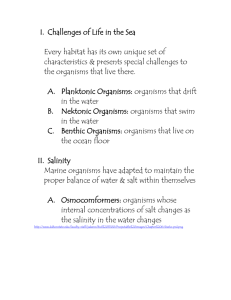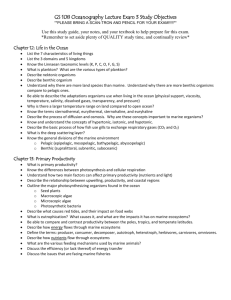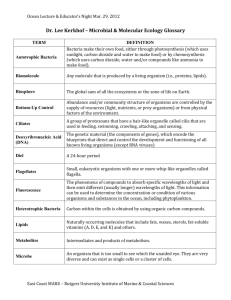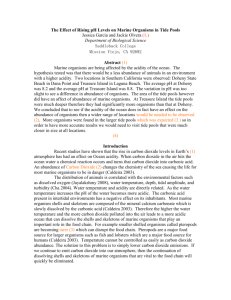Garcia and Olvera - Saddleback College
advertisement
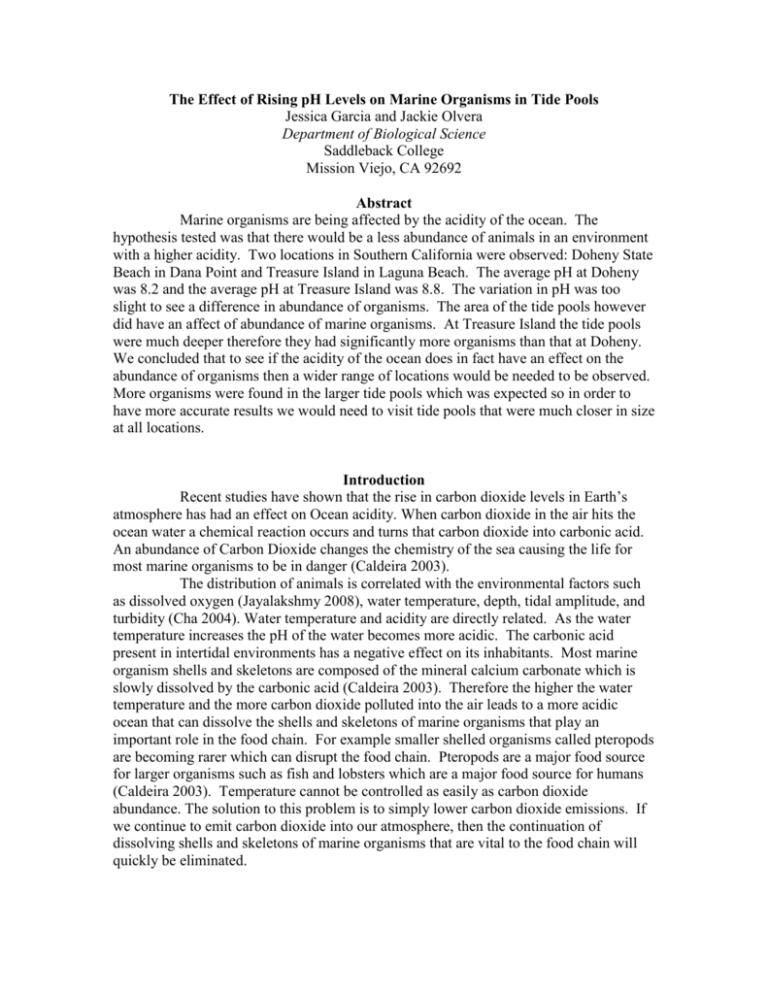
The Effect of Rising pH Levels on Marine Organisms in Tide Pools Jessica Garcia and Jackie Olvera Department of Biological Science Saddleback College Mission Viejo, CA 92692 Abstract Marine organisms are being affected by the acidity of the ocean. The hypothesis tested was that there would be a less abundance of animals in an environment with a higher acidity. Two locations in Southern California were observed: Doheny State Beach in Dana Point and Treasure Island in Laguna Beach. The average pH at Doheny was 8.2 and the average pH at Treasure Island was 8.8. The variation in pH was too slight to see a difference in abundance of organisms. The area of the tide pools however did have an affect of abundance of marine organisms. At Treasure Island the tide pools were much deeper therefore they had significantly more organisms than that at Doheny. We concluded that to see if the acidity of the ocean does in fact have an effect on the abundance of organisms then a wider range of locations would be needed to be observed. More organisms were found in the larger tide pools which was expected so in order to have more accurate results we would need to visit tide pools that were much closer in size at all locations. Introduction Recent studies have shown that the rise in carbon dioxide levels in Earth’s atmosphere has had an effect on Ocean acidity. When carbon dioxide in the air hits the ocean water a chemical reaction occurs and turns that carbon dioxide into carbonic acid. An abundance of Carbon Dioxide changes the chemistry of the sea causing the life for most marine organisms to be in danger (Caldeira 2003). The distribution of animals is correlated with the environmental factors such as dissolved oxygen (Jayalakshmy 2008), water temperature, depth, tidal amplitude, and turbidity (Cha 2004). Water temperature and acidity are directly related. As the water temperature increases the pH of the water becomes more acidic. The carbonic acid present in intertidal environments has a negative effect on its inhabitants. Most marine organism shells and skeletons are composed of the mineral calcium carbonate which is slowly dissolved by the carbonic acid (Caldeira 2003). Therefore the higher the water temperature and the more carbon dioxide polluted into the air leads to a more acidic ocean that can dissolve the shells and skeletons of marine organisms that play an important role in the food chain. For example smaller shelled organisms called pteropods are becoming rarer which can disrupt the food chain. Pteropods are a major food source for larger organisms such as fish and lobsters which are a major food source for humans (Caldeira 2003). Temperature cannot be controlled as easily as carbon dioxide abundance. The solution to this problem is to simply lower carbon dioxide emissions. If we continue to emit carbon dioxide into our atmosphere, then the continuation of dissolving shells and skeletons of marine organisms that are vital to the food chain will quickly be eliminated. Marine organisms already have other dangers to worry about such as predators. For example in areas where starfish are more abundant sea urchins tend to emigrate from that environment (Schroeter 1983). Most marine organisms are capable of adapting to other environmental changes such as turbidity. Not only do shelled organisms suffer from the rise in pH of the ocean but coral reefs are also struggling to survive (Smith 1992). Scientists are considering ocean acidification as the other carbon problem with the first carbon problem being global warming. The first step to solving this problem is lowering the carbon dioxide emissions given off from automobiles. Doing this can also help the ozone layer and ultimately halt the ocean acidity problem. Methods & Materials Observations were determined during low tide in November of 2009 for the following two locations: Doheny State Beach in Dana Point, California and Treasure Island Beach in Laguna Beach, California. The locations were selected by their variations in pH levels. At each location three tide pools of various sizes (small, medium, and large) was observed calculating the area for each using a tape measure. Having once determined the area calculations of the tide pools, all organisms visible were counted within each pool. Determining the quantity of each organism found in the tide pools, allowed us to foresee any possible differences that could potentially be affected due to its levels of pH. Among the organisms discovered were the Amthopleura xanthogrammica (sea anemone), Pisaster ochraceus (sea star), Mytilus californianus (California mussel), Pagurus samuelis (hermit crab), Tegula funebralis (snail), Octopus vulgaris (common octopus), and Aplysia californica (sea hare). The pH at both locations was determined by using a pH probe provided by Professor Steve Teh, Professor of Biological sciences at Saddleback College. Results In Table 1, the frequency of organisms was graphed according to their location and size of tide pool they were located in. This indicates that organisms were more abundant at the tide pools located at Treasure Island, specifically in the large tide pool. In Table 2, the amount of each individual species observed was graphed along with the pH of the tide pool it was located in. The results indicated that there was a difference in the abundance of organisms located in tide pools with different acidity levels. The average pH of the tide pools located at Doheny State Beach was 8.2 and the average pH of the tide pools located at Treasure Island was 8.9. There was a difference in the abundance of organisms at both locations due to there varying pH levels. More organisms were found in the tide pools at Treasure Island than at Doheny State Beach. Table 1 60 Mean Frequency 50 40 Doho 30 T.Isle 20 10 0 Small Medium Large Table 1 caption: Bar graph displaying the mean frequency of marine organisms in tide pools at the locations of Doheny State Beach (Doho) and Treasure Island (T. Isle). Table 2 250 Sea Anemone 200 Frequency Mussels Snails 150 Hermit Crabs 100 Starfish Sea Slug 50 Octopus 0 8.2 8.9 pH Table 2 caption: Bar graph displaying the amount of total organisms of a specific species found in different levels of pH. Discussion The acidity level in intertidal environments has been shown to have a negative effect on shelled organisms. Shells are beginning to slowly dissolve due to the acidity of the ocean which is created by the carbon dioxide emissions given off by various creations made by the Industrial Revolution. We tested this by measuring the pH of marine environments at two different locations in Southern California. Along with the pH readings we counted the amount of organisms present of different species. The species included were sea anemones, mussels, snails, hermit crabs, sea stars, sea hares, and octopus. The area of each tide pool was also conducted by measuring length, width, and depth. Our results indicate that our hypothesis was supported however the difference in the abundance of organisms found in the different pH environments was too slight to make an assertive decision with confidence. The area of each tide pool indicated that there was a more abundance of marine organisms living in larger environments. Further investigation is required in order to justify these results with confidence. Literature Cited Cha HR, Buddemeier RW, Fautin DG, Sandhei P. 15 November 2004. Distribution of sea anemones (Cnidaria, Actiniaria) in Korea analyzed by environmental clustering. Hydrobiologia. 430(Sp. Issue):497-502 Jayalakshmy KV, Saraswathy M, Nair M. 20 August 2008. Effect of water quality parameters on the distribution of Pleuromamma (Copepoda-Calanoida) species in the Indian Ocean: a statistical approach. Environmental Monitoring and Assessment. 155(1-4): 373-392 Schroeter SC, Dixon J, Kastendiek J. 1983. Effects of the starfish Patiria miniata on the distribution of the sea-urchin Lytechinus anamesus in a southern Californian kelp forest. Oecologia. 56(2-3):141-147 Smith, S. V. and R. W. Buddemeier. 1992. Global change and coral-reef ecosystems. Annual Review of Ecology and Systematics 23:89-118 Caldeira K, Wickett ME. 2003. Anthropogenic carbon and ocean pH. Nature 425:365-365





